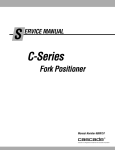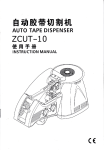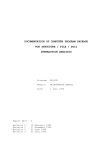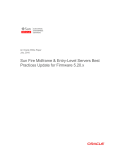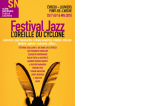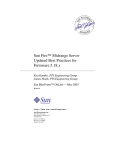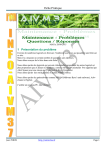Download Paper - Asee peer logo
Transcript
Session 2260 Robotics Synchronization And Information Distribution System (RSAIDS) Gary R. Boucher Associate Professor [email protected] Reza Sanati Mehrizy Associate Professor [email protected] Alfered L. McKinney Professor [email protected] Afsaneh Minaie Associate Professor [email protected] College of Sciences Louisiana State University in Shreveport Shreveport, LA 71115 School of Computer Science and Engineering Utah Valley State College Orem, Utah 84058 Abstract Since our schools do not offer an engineering program, we teach robotic technology within our computer science curriculum. In the process of teaching robotics technology to students at a graduate or undergraduate level, it becomes necessary to synchronize more than one robotic arm for the purpose of demonstrating the interaction between robots commonly found in industrial settings. There are several approaches to doing this. The simplest approach is to connect the two machines with hard-wiring. This requires the operator to connect outputs of one machine to the inputs of another. Perhaps the reverse will be also necessary in connecting the outputs of the second robotic controller to the first. Another method of synchronization involves the use of expensive industrial quality programmed controllers using ladder logic to evoke responses from the affected robots based on certain inputs. Most Computer Science and Computer Technology students are not familiar with such controllers but do possess a well based knowledge of several computer languages. The third approach and the topic for the RSAIDS approach is to use a microprocessor to control the synchronization of the robotic arms. The main problem with this third approach is the fact that microcontrollers or microprocessors such as the MC68HC11 series used in the RSAIDS are difficult to program in assembly language without prior experience. Page 9.1074.1 Proceedings of the 2004 American Society of Engineering Education Annual Conference & Exposition Copyright © 2004, American Society for Engineering Education The RSAIDS which we have developed has an assembly language program that translates signals between the robotic controllers and a "Host" computer. The RSAIDS is capable of synchronizing several robotic arms using a single “Host” computer. All that is necessary for communications between the host and the separate controllers is the knowledge of a primitive set of communications instructions understood by the RSAIDS unit. This unit has been designed and constructed for around $100.00. This paper elaborates the design, construction, and application of RSAIDS in details including hardware and software requirements in details. Communications with Robot Arm Controllers There are two main methods for input and output of information to most robotic controllers. There exists a serial channel associated with the controllers, which allows data input and output, to and from a host computer2. This can be a viable alternative to communication and synchronization with these systems. However, this requires a substantial amount of programming by the student to achieve synchronized operation of multiple robots. The student also can use the simple ON/OFF digital input and output interface via the front terminal connectors found on the controllers3. These connectors represent the most widely used approach where the student can make direct electrical connection between the controller devices. In the robotics lab students use the Advanced Control Language (ACL) provided by the robot vendor to write robotic control programs2. This language has a built-in set of I/O functions that allow the setting and clearing of output bits and the reading of input bits. Input information can be tested in IF statements to branch or hang at one certain location in the program until the bit is either set or cleared to allow the program to proceed to the next step. In short, bits can be set and tested under ACL program control in an easy and straightforward manner. The Purpose of RSAIDS Wiring two or more controllers together using cabling often meets with limited success as the student must master both the control language along with the proper methods of wiring the controllers. This problem of wiring is multiplied when over two controllers are to function in synchronization. RSAIDS is an approach to greatly facilitate connections of multiple controllers where the combined operation of the robots can be brought to a simple software level using an easy to learn control language. To do this requires a small degree of both rudimentary hardware and assembly language microcontroller software. RSAIDS represents a model, which can be modified as needed to meet these minimal requirements. Sample software and hardware interfacing schematics are provided in Appendix A as a final design, or a base for further development. Proceedings of the 2004 American Society of Engineering Education Annual Conference & Exposition Copyright © 2004, American Society for Engineering Education Page 9.1074.2 RSAIDS Communications with Host The hardware for support of the RSAIDS software functions can be virtually any of the readily available prototype board systems that support the Motorola MC86HC11 family of microcontrollers. Most of the industry’s available board systems for these widely utilized MCUs have built-in RS-232C ports. Also, these board systems have most, if not all of their pins made available for interface to user-developed I/O devices. Schematics are provided in Appendix A showing a suggested approach to both input and output interfacing. This interface hardware is all that is needed to connect the basic MCU to the robot controller logic. Both of these circuits can be implemented via a printed circuit board or using wire wrap technology. The RSAIDS built-in RS-232C serial interface is connected directly, or with the use of a null modem, to the host computer's serial adapter usually on COM1 or COM2. Most computers come with this capability via a male DB-9 connector on the back panel. Some newer computers without built-in RS-232C capability may require a Universal Serial Bus (USB) adapter to convert to the serial protocol. The RSAIDS unit is setup to communicate at a fixed 9600 Baud. This can be changed, but only by those experienced in communications with the Motorola BUFFALO Monitor system found in the MC68HC711E9 processor chip on the RSAIDS4. Faster speeds should consider the serial cable length and the possibility of data corruption seen with fast baud rates and long cabling1. The protocol for transmission via the RSAIDS is 8-bit, no parity, with one stop bit. This is standard for most modern communication applications. Hardware Connection to Controllers Although numerous configurations may exist for interfacing the RSAIDS unit to the robot controllers, the prototype used two inexpensive and readily available DB-25 connectors to carry the I/O logic lines to and from the enclosure housing the unit. Each DB-25 can be the connection point for several multiple-wire cables going to the robot controllers. It is suggested that these cables use breakout boxes at their ends to facilitate connection to the controllers. Pins are provided on the controllers for screw terminal connection. It should be noted that active low input/output is present on all controllers. Thus, if the controllers input is 0 Volts the input is considered logic HIGH. For 5 Volts the input is considered logic LOW. This is taken into consideration in the RSAIDS software and reversed so that logic (1) in the ACL software at the controller site is a logic (1) at the Host. Power Connection to the RSAIDS The RSAIDS prototype unit runs on 9 Volts DC. This power is supplied by a standard plug in power module as used by many modern electronic devices. There is no power switch on this RSAIDS unit. If re-initialization is required, the operator simply unplugs the power from the 9 Volt wall power adapter cord where it goes into the power plug on the RSAIDS then reinsert the cord into the RSAIDS a second or two later. Although this is somewhat more inconvenient than using a reset button, there are few times that reset of the RSAIDS has been required. RSAIDS Communication Commands The command interface between the RSAIDS unit and the host computer is simple and straightforward. When the RSAIDS unit is powered up, internal software initializes the serial communications port of the device. This initialization requires the issuance of a single Carriage RETURN <CR> character from the host. Therefore the RSAIDS will not be in communications mode before this character is received. It is thus the responsibility of the host to provide this character after the power-up of the RSAIDS. After power-up and initialization with the <CR> character, the RSAIDS is ready for use. There are four types of commands that can be sent from the host to the RSAIDS. These are listed below: Proceedings of the 2004 American Society of Engineering Education Annual Conference & Exposition Copyright © 2004, American Society for Engineering Education Page 9.1074.3 Write Single Output (Shown by Example) WB2H<CR> This Writes from the Host to controller B's input 2 a logic High. WA3L<CR> This Writes from the Host to controller A's input 3 a logic Low. If the above commands are of the correct syntax they will be echoed back including the <CR> at the end. If not accepted, the echo back to the host computer will be E<CR> for Error. Read Single Input (Shown by Example) RC1<CR> This is a command to Read output 5 from controller C. (*) RA3<CR> This requests a Read of output 7 from controller A. (*) If the command was accepted the return will be a X<CR> where "X" is either a "0" or a "1". If the command was not accepted the return will be E<CR> . Write-All (Shown by Example) W-1011001001011101<CR> - This writes all outputs at the same time. The first "1" following the "-" is for controller A's input 1. The next bit, a "0" goes to controller A's input 2. The fifth bit from the "-" is a "0" which sends a Logic Low to controller B's input number 1. The right most bit, a "1" writes a logic High to controller D's input bit number 4. After each Write-All the entire string of 18 characters is echoed back to the controller followed by a <CR>. If there is an error only E<CR> will be echoed back to the host. Read-All (Shown by Example) R-<CR> This command returns the following string to the host computer: R-XXXXXXXXXXXXXXXX<CR>. The first "X" represents controller A's output 5. The second "X" represents output 6 from controller A. Since there are only three inputs to the host from each controller the 4th, 8th, 12th, and 16th "X" has no meaning and must be ignored. Later modifications to the RSAIDS could enable a 4th controller-output (host-input) if more connection wiring is provided beyond what exists currently. In the event that the syntax was incorrect the standard E<CR> will be returned to the host computer. (*) Note: The first four outputs of each controller are relay type outputs and are numbered 1 through 4. These are reserved and not connected to the RSAIDS. Rather, controller output 5, 6, and 7 are used to return information to the RSAIDS. The software and thus commands provided with the RSAIDS unit consider these controller-outputs (host-inputs) to be numbers 1, 2, and 3. Thus the operator must be aware that controller output number 5 is actually seen as input number 1 to the host. Proceedings of the 2004 American Society of Engineering Education Annual Conference & Exposition Copyright © 2004, American Society for Engineering Education Page 9.1074.4 There is one type of command used to send controller output information to the host without any type of prompting. The RSAIDS looks at the outputs from the controller constantly. If there is any change in any controller output the RSAIDS sends a response to the host. This response is in the form of the serial string I-XXXNXXXNXXXNXXXN<CR> , which is received by the host. Thus, each time one or more controller outputs change, the host sees the change without polling the RSAIDS. If a certain controller output goes High and then Low the Itype string will be sent twice to the host; once when the line goes High and the other when the line falls Low. The "X" characters represent controller output A1 through D3. The "N" characters represent "Don't Care" values because as stated earlier, they are not connected to the RSAIDS. Event driven software takes this I-type ("I" is for Interrupt) command and does what is necessary when the change occurs and nothing when there is no host input change. Design Factors for Host Computer Software Much care must be taken on the part of the student endeavoring to write robotic control software. If there are 4 robots to be interfaced there will have to be 5 programs in all to synchronize the operation desired. Four will be ACL language programs and the fifth will be the host computer program. The host program requirements are flexible and may be written in numerous languages including Visual BASIC, Quick BASIC, Pascal, C, C++, or Assembly language. It is the desire of the authors to see a universal package written, perhaps in Visual BASIC that will provide a simple visual interface for the user. Considerations for such software either as a platform or just a simple program created by the user must include several major considerations. First, Write Commands require as long as 20mS from the time that a command is sent to the RSAIDS unit before the actual lines are pulled high or low on the controllers. Returning information such as the command itself that was issued or data from controller outputs, error messages etc. must be input into the host language to obtain the full features of the RSAIDS unit. This too takes up to 20mS. Each character send serially takes about 1.2mS on average to go to/from the host computer. Changes in the outputs from the controllers issue a command in the form of IXXXNXXXNXXXNXXXN<CR> , as explained above. This data string will require capture and interpretation to analyze what bit or bits have changed. For this type of capture an "Event Driven" software will prove to be far superior to languages that have to "Poll" the host input status with the R-<CR> command. Commands can be given too fast from a fast host. For example; if you need a low-to-high-tolow pulse sent to input number 1 on a certain controller. Data have been lost in this process because the host language sent the commands too fast for the RSAIDS to capture them serially and respond. Delay routines are needed in some cases to allow the programmer to first send the command to go High and wait for a prescribed number of milli-seconds before the line is pulled Low again. Likewise, the controller can output data high and then low fast enough that the RSAIDS can not catch either or both of the transitions. Considerations vary from one host computer to another and from one type of host software to another. Perhaps in the future an enterprising student will obtain a "Special Problems" credit for designing a host software user-friendly platform for this application. Proceedings of the 2004 American Society of Engineering Education Annual Conference & Exposition Copyright © 2004, American Society for Engineering Education Page 9.1074.5 Results and Conclusions The capability of the RSAIDS unit has been demonstrated with the use of multiple SCORBOT-ER Vplus robot arms and a controller operated turntable. Microsoft Visual Basic was used to send and receive commands to the RSAIDS unit. This proved viable, but the conclusion of both faculty and senior-level student programmers was that any viable software program capable of sending and receiving via the RS-232C serial port should be usable. The fact that Visual Basic is an event-driven language allows for a great deal of latitude in asynchronously generated events. From the above facts and personal experience with the use of the RSAIDS unit it was judged by the investigators to be a successful tool for student application to real-time robotics control. Availability of Technical Information The authors possess assembly language listings files and other technical materials, which can be disseminated freely to those interested in development of their own RSAIDS or similar unit. The authors welcome inquiries and requests. Bibliography [1] [2] [3] [4] Motorola Inc., MC68HC11 Reference Manual, Motorola Inc., 1991. Eshed Robotec, Ltd., ACL Advanced Control Language Reference Guide for Controller-A 4th Edition, January 1995. Eshed Robotec, Ltd., SCORBOT-ER Vplus User's Manual 3rd Edition, pp. 3-5 through 3-10, February 1996. Barry B. Brey, Microprocessors and Peripherals Hardware, Software, Interfacing, and Applications Second Edition, Merrill Publishing Company, Columbus, Ohio, page 272, 1988. Biography Reza Sanati_Mehrizy is an associate professor of the Computing and Networking Sciences Dept. at Utah Valley State College, Orem, Utah. He received his MS and PhD in Computer Science from University of Oklahoma, Norman, Oklahoma. His research focuses on diverse areas such as: Database Design, Data Structures, Artificial Intelligence, Robotics, and Computer Integrated Manufacturing. Afsanaeh Minaie is an assistant professor in the Computing and Networking Sciences Department at Utah Valley State College. She received a B.S., M.S., and Ph.D. all in Electrical Engineering from University of Oklahoma in 1981, 1984 and 1989 respectively. Her current interests are in computer architecture, digital design, and computer interfacing. Alfred L. McKinney is professor of Computer Science at Centenary College of Louisiana. He received a B.S. in 1959 and a M.S. in 1961 from Louisiana Tech University and a Ph.D. in Mathematics from University of Oklahoma in 1972. Gary R. Boucher is an associate professor of physics at Louisiana State University in Shreveport. He received a B.S., M.S., and Ph.D. in Engineering from Louisiana Tech University. Page 9.1074.6 Proceedings of the 2004 American Society of Engineering Education Annual Conference & Exposition Copyright © 2004, American Society for Engineering Education Appendix A Page 9.1074.7 Proceedings of the 2004 American Society of Engineering Education Annual Conference & Exposition Copyright © 2004, American Society for Engineering Education * RSAIDS.ASM * OPT * * Equates PORTA PORTC PORTD DDRC DDRD BAUD SCCR2 PACTL OPTION RTIVECT TMSK2 TFLG2 OUTPUT INPUT STACK BUFFALO CRETN Section EQU EQU EQU EQU EQU EQU EQU EQU EQU EQU EQU EQU EQU EQU EQU EQU EQU ORG c $1000 $1003 $1008 $1007 $1009 $102B $102D $1026 $1039 $00EB $1024 $1025 $FFAF $FFAC $01FF $E000 $0D $0000 Port A Port C Port D Data Direction for C Data Direction for D Baud Register (9600) SCI Control Register 2 For A7 direction Option Register RTI Vector Location RTI Enable Bit RTI Flag Bit Register Send Byte Out Input Char or (0) Stack Pointer Buffalo's Starting Location Carriage Return Page 9.1074.8 Proceedings of the 2004 American Society of Engineering Education Annual Conference & Exposition Copyright © 2004, American Society for Engineering Education * RAM Variables Section FLAG: IBUFF: COMPT: CHANL: HILOW: DC_BYT: BA_BYT: DC_MSK: BA_MSK: U4: U3: LASTU4: LASTU3: XBIT: RMB RMB RMB RMB RMB RMB RMB RMB RMB RMB RMB RMB RMB RMB ORG 1 20 1 1 1 1 1 1 1 1 1 1 1 1 $B600 Indicator for RTI System Input Buffer for Commands Computer Designator (A-D) Channel (1-4) High Low for Writing (H, L) Byte for D&C Output Byte for A&B Output Mask Byte for R/W on D&C Mask Byte for R/W on B&A Tri-State Data Read Tri-State Data Read U4's Contents On Last Read U3's Contents On Last Read Used With Don't Care States Proceedings of the 2004 American Society of Engineering Education Annual Conference & Exposition Copyright © 2004, American Society for Engineering Education Page 9.1074.9 * This Subroutine does an Init to the System. INIT: LDS #STACK Set the Stack Pointer LDAA #$0C Set PD2 and PD3 to High STAA PORTD Store in PORTD LDAA DDRD Get Data Dir for D ORAA #$0C Make PD2 and PD3 Output STAA DDRD Store New Directions CLRA A=$00 STAA PORTA Strobes to Zero COMA A=$FF STAA PORTC Port C to Zeros STAA DDRC Make All Pins on C Output LDAA #$60 Strobe Mask for A STAA PORTA Make PA5 and PA6 High CLR PORTA Clear Strobes for Output CLR DDRC PORTC is now Input Only CLR DC_BYT Output Status Bytes CLR BA_BYT JSR READINP Get Initial Values LDAA U4 Make Last the Latest STAA LASTU4 LDAA U3 Make Last the Latest STAA LASTU3 LDD #RTISER Address of RTI Service STD $00EC Rewrite Vector for RTI LDAA PACTL RTI Control Register ORAA #$03 Make RTI 32mS STAA PACTL Store it Back LDAA TMSK2 Set RTII to (1) ORAA #$40 Mask Needed STAA TMSK2 Store it Back LDAA TFLG2 Get RTI RTIF Flag ORAA #$40 Clear it STAA TFLG2 Store it Back CLR FLAG RTI Permission Flag CLI Allow Interrupts (RTI) * Beginning of Program Loop BEGNLP: LDX #IBUFF CLR FLAG INC FLAG ILOOP: JSR SCINPUT STAA 0,X INX CMPA #$0D BEQ FNLOOP CPX #IBUFF+20 BNE ILOOP CLR FLAG JMP ERROR FNLOOP: CLR FLAG LDX #IBUFF LDAA 0,X INX CMPA #'R' BNE NOTRD JMP READ NOTRD: CMPA #'W' BNE BADW JMP WRITE BADW: JMP ERROR It was Not a 'R' or 'W' Get the Flags Set to Clear RTIF Flag Clear Flag Test RTI Permission Flag If FLAG=0 then RTI Read U4, U3 Look at U3 Is U3 Same as Last Time? If Same Branch If Not Same then Make Equal Branch to Not Same Part Look at U4 Is it the Same as Before? If Same End RTI Store New U4 to Last U4 Something Changed End RTI Beginning of Response Send it Get the '-' for the Response Send it There are 16 Lines to Read Save B Get Both U4 and U3 Shift Right into Carry (CY) Store Back the Double Byte Restore B If CY=1 then Branch CY Must Have been a Zero Proceedings of the 2004 American Society of Engineering Education Annual Conference & Exposition Copyright © 2004, American Society for Engineering Education Page 9.1074.10 * RTI Service Routine. RTISER: LDAA TFLG2 ORAA #$40 STAA TFLG2 TST FLAG BEQ RTIEND JSR READINP LDAA U3 CMPA LASTU3 BEQ SAMEU3 STAA LASTU3 BRA NTSAME SAMEU3: LDAA U4 CMPA LASTU4 BEQ RTIEND STAA LASTU4 BRA NTSAME RTIEND: RTI NTSAME: LDAA #'I' JSR OUTPUT LDAA #'-' JSR OUTPUT LDAB #16 RTILOOP: PSHB LDD U4 LSRD STD U4 PULB BCS OUT_1 LDAA #'0' Point X to Buffer Area First Zero Flag RTI Permission to READINP Go Get a Character Store the Character in Buffer Point to Next Buffer Char Was Char a RETURN? If RETURN Char then Finish Past End of Buffer? If Not Excessive Length Loop End Permission READINP to RTI Too Many Characters ERROR! End Permission for RTI READ Repoint X to Start of Buffer Load a Buffer Character Point to Next Buff Character Is the Operation a READ? If Not a READ then Try WRITE This is a READ Operation Was the Operation a WRITE? If a WRITE then Go There OUT_1: BTLP: JSR BRA LDAA JSR DECB BNE LDAA JSR RTI OUTPUT BTLP #'1' OUTPUT RTILOOP #CRETN OUTPUT Send Loaded '0' to Host Continue to RDAL1 CY=1 So Send a '1' to Host Send the '1' Count down the 16 Bits If Not Zero Yet then Do Again Load a RETURN <CR> Send CR *************************************************************** * * * * * * * * * * * * SUBROUTINES * * * * * * * * * * * * * *************************************************************** Proceedings of the 2004 American Society of Engineering Education Annual Conference & Exposition Copyright © 2004, American Society for Engineering Education Page 9.1074.11 ORG $D000 * This program module is used to allow the Host Computer * to write to the Robots. It is executed when a 'W' * Character is found as the first element in the IBUFF WRITE: LDAA 0,X Get Next Character INX Point to Next Character CMPA #'-' Is the Character a '-'? BNE WRT1 If Not a Write-All then Brch JMP WRTALL A Write-All Command WRT1: CMPA #'A' Check Lower Range BHS WRT2 'A' or Higher is OK JMP ERROR Below 'A' is Not OK WRT2: CMPA #'D' Check for the 'D' Computer BLS WRT3 'D' or Less Is OK JMP ERROR Above 'D' is Not OK WRT3: STAA COMPT Put 'A'-'D' in COMPT Location LDAA 0,X Get Next Character INX Point to Next Buffer Element WRT4: CMPA #'1' Channel 1-4... Compare to '1' BHS WRT5 '1' or More is OK JMP ERROR ERROR if Below '1' WRT5: CMPA #'4' Compare to '4' BLS WRT6 '4' or Less is OK JMP ERROR ERROR if Above '4' WRT6: STAA CHANL Record Channel Value for Later LDAA 0,X Get Next Buffer Element INX Point to Next Buffer Element CMPA #'L' Is it a LOW? BEQ WRGOOD LOW is OK CMPA #'H' Is it a HIGH? BEQ WRGOOD HIGH is OK JMP ERROR Not HIGH or LOW! WRGOOD: STAA HILOW Store as 'H' or 'L' JSR POSIT Make DC_MSK and BA_MSK LDAA HILOW Get HILOW ('H' or 'L') CMPA #'L' Is HILOW = 'L'? BEQ MKLOW If So then Make Bit LOW MKHIGH: LDAA DC_MSK HILOW Must have Been 'H' ORAA DC_BYT Make Bit High STAA DC_BYT Store Back in DC_BYT LDAA BA_MSK Get B&A Mask Byte MKLOW: WRTIT: ORAA STAA BRA LDAA COMA ANDA STAA LDAA COMA ANDA STAA COMA STAA BSR LDAA COMA STAA BSR JSR JMP BA_BYT BA_BYT WRTIT DC_MSK DC_BYT DC_BYT BA_MSK BA_BYT BA_BYT PORTC STB_BA DC_BYT PORTC STB_DC WRT_BUF BEGNLP Make Bit High Store Back in BA_BYT Go Write It Get DC Mask Byte Make 1's Compliment Make Bit Zero Store Back Load Next Bit Mask 1's Compliment Make Bit LOW Store it Back Compliment Before Output Put BA_BYT to PORTC Strobe PORTC to u1 Load Next Byte Compliment Before Output Store it to PORTC Strobe PORTC to u2 Original Command to Host Finished Echoing Input Back * This routine strobes the information just previously written * to the C Port into U1 or U2 STB_BA: SEI Prohibits I-Type Interrupts LDAB PORTD Get Tri-State Strobe Byte ORAB #$0C Disable Both Strobes STAB PORTD Write It Back LDAB #$FF For DDRC STAB DDRC Make All PORTC Pins Output LDAB PORTA Get PORTA Strobes ORAB #$40 Make PA6 HIGH STAB PORTA Store Strobes Back ANDB #$BF Make Bit PA6 LOW STAB PORTA Strobe Bit Now Zero Again CLR DDRC Sets PORTC to INPUT CLI Lets Interrupts Occur Again RTS * This routine strobes the information just previously written * to the C Port into U1 or U2 STB_DC: SEI Prohibits I-Type Interrupts LDAB PORTD Get Tri-State Strobe Byte #$0C PORTD #$FF DDRC PORTA #$20 PORTA #$DF PORTA DDRC Disable Both Strobes Write It Back For DDRC Make All PORTC Pins Output Get Strobes Make PA5 High Store it Make PA5 LOW Strobe Bit Now Zero Again Sets PORTC to INPUT Lets Interrupts Occur Again * This program module writes 16 0's or 1's to the entire system. Proceedings of the 2004 American Society of Engineering Education Annual Conference & Exposition Copyright © 2004, American Society for Engineering Education Page 9.1074.12 ORAB STAB LDAB STAB LDAB ORAB STAB ANDB STAB CLR CLI RTS * Example: To write to all 16 outputs enter the following * command or a variant: * W-1011000101111010<CR> The first 4 bits are for Computer A * The second 4 are for Computer B etc. * A1=1, A2=0, A3=1, A4=1 WRTALL: LDY DC_BYT Current Value of Output LDAB #16 After '-' There are 16 0's or 1's WRLOOP: LDAA 0,X Get The First 0 or 1 INX Point to Next Char in Buffer CMPA #'X' Don't Care Operator BEQ BIT_OK Don't Care is OK CMPA #'0' Is the Char a '0'? BEQ BIT_OK If So it is OK CMPA #'1' Is the Char a '1'? BEQ BIT_OK If So it is OK JMP ERROR A Char was NOT '0' or '1' BIT_OK: PSHA Save A & B for Later PSHB XGDY Exchange D and Y LSRD Shift Output Info into CY BCS BMB1 If CY=1 Set XBIT=$01 CLR XBIT If Current Data=0 then XBIT=0 BRA XFOUND Finished with XBIT Determine BMB1: CLR XBIT XBIT=1, Start With XBIT=0 INC XBIT XBIT=1 XFOUND: XGDY Current Data Back in Y PULB Restore A & B PULA CMPA #'X' Was it a Don't Care? BNE NOTANX If NOT an 'X' Branch LDAA XBIT Was an 'X', Look at XBIT NOTANX: RORA Right Most Bit of ASCII into (CY) ROR DC_BYT (CY) Into MSD of DC_BYT ROR BA_BYT LSB of DC_BYT Into MSD of BA_BYT DECB One Char Processed. Decr. (B) BNE WRLOOP Branch if (B) Not Zero. Get Another LDAA 0,X Check for RETURN at End CMPA #$0D Is it a RETURN <CR> BEQ WROK If so GOOD! Finish JMP ERROR Was Not a RETURN at End. Bad! WROK: LDAA DC_BYT Get Loaded Byte for D&C COMA Compliment STAA PORTC Send it to Port C JSR STB_DC Strobe it Out. LDAA BA_BYT Get BA Byte COMA Compliment STAA PORTC Send it to Port C JSR STB_BA Strobe it Out JSR WRT_BUF Success! Write the Command to Host JMP BEGNLP Do it All Over Again. Proceedings of the 2004 American Society of Engineering Education Annual Conference & Exposition Copyright © 2004, American Society for Engineering Education Page 9.1074.13 * This subroutine writes out the contents of the input * buffer after a successful command execution. WRT_BUF: LDX #IBUFF Point (X) to Start of Buff WREPLY: LDAA 0,X Get Byte from Buffer JSR OUTPUT Send it to Host Computer WFIN: CMPA BEQ INX BRA RTS #$0D WFIN WREPLY Was the Byte a RETURN? If Last Byte Sent a RETURN Point to Next Buffer Element Do it Again * This subroutine reads a char from INPUT in BUFFALO. If there * is no char then INPUT returns a zero which causes this sub * to loop and look for a non-zero character. The execution * stays here till a character is entered. SCINPUT: JSR INPUT Buffalo Input TSTA Was there an Input? BEQ SCINPUT If No Input Branch RTS Finished * This is the read module of the program. This is both for * single reads and Read-Alls. READ: LDAA 0,X Get Next Character INX Point to Next Character CMPA #'-' Read All Channels BNE RD1 If Not a '-' then Branch JMP RDALL Otherwise Read All RD1: CMPA #'A' Check Lower Range BHS RD2 'A' or Higher is OK JMP ERROR Below 'A' is Not OK RD2: CMPA #'D' Check for the 'D' Computer BLS RD3 'D' or Less is OK JMP ERROR Above 'D' is Not OK RD3: STAA COMPT Put 'A'-'D' in COMPT Location LDAA 0,X Get Next Character INX Point to Next Buffer Element RD4: CMPA #'1' Channel 1-4... Compare to '1' BHS RD5 '1' or More is OK JMP ERROR ERROR if Below '1' RD5: CMPA #'4' Compare to '4' BLS RD6 '4' or Less is OK JMP ERROR ERROR if Above '4' RD6: STAA CHANL Record Channel Value for Later JSR READINP Load Contents into U3 and U4 JSR POSIT Make DC_MSK and BA_MSK LDAA DC_MSK Get Mask Byte ANDA U4 And with DC Memory Location STAA U4 Store May or May not have a (1) LDAA BA_MSK Get BA Mask Byte ANDA U3 AND it with U3's Data ADDA U4 U3 or U4 (May) Have a (1) TSTA Test A for Setting Flags BEQ RZRO Go Load a Zero LDAA #'1' Load the '1' BRA RD7 Go Send a '1' RZRO: LDAA #'0' Load the '0' RD7: JSR RETURN Go Write it as a Response JMP BEGNLP Do the Whole Thing Over Proceedings of the 2004 American Society of Engineering Education Annual Conference & Exposition Copyright © 2004, American Society for Engineering Education Page 9.1074.14 * This program module is activated by an input of 'R-' followed * by a RETURN. The successful response to the Host is: * R-00010110100101110101 where the left most (0) is A1 and the * right most (1) is D4 RDALL: LDAA #'R' Get the 'R' for the Response JSR OUTPUT Send it LDAA #'-' Get the '-' for the Response JSR OUTPUT Send it JSR READINP Go Read Input into CD_BYT, BA_BYT LDAB #16 There are 16 Lines to Read RDALOOP: PSHA Store A and B PSHB LDD U4 Get Both U4 and U3 LSRD Shift Right into Carry (CY) STD U4 Store Back the Double Byte PULB Restore A and B PULA BCS OUT_ONE If CY=1 then Branch OUT_ZERO: LDAA #'0' CY Must Have been a Zero JSR OUTPUT Send Loaded '0' to Host BRA RDAL1 Continue to RDAL1 OUT_ONE: LDAA #'1' CY=1 So Send a '1' to Host JSR OUTPUT Send the '1' RDAL1: DECB Count down the 16 Bits BNE RDALOOP If Not Zero Yet then Do Again LDAA #CRETN Load a RETURN <CR> JSR OUTPUT Send CR JMP BEGNLP Do the Big Loop Again * This routine enables the strobes for U3 and U4 one at a time * and records the information in U3 and U4. These locations * correspond to the ICs (Tri-State Devices) that capture the * information. READINP: CLR DDRC Makes C Input on ALL Pins LDAA PORTD Get D Port ANDA #$FB Make PD2 Low STAA PORTD Store it Back in Port D PSHA Save Port D Bits For Later LDAA PORTC Capture Information for A&B COMA Compliment for Controller STAA U3 Store A&B in U3 Memory Location PULA Get Port D Info Back in (A) ORAA #$0C PD2 and PD3 High (Disable U3, U4) STAA PORTD Store Back in Port D ANDA #$F7 Make PD3 Low (Enable U4) STAA PORTD Store it Back LDAA PORTC Get U4 Data COMA Compliment for Controller STAA U4 Store it in U4 LDAA PORTD Get PORTD with Strobes ORAA #$0C Make PD2 and PD3 High (Disable) STAA PORTD Store it RTS Proceedings of the 2004 American Society of Engineering Education Annual Conference & Exposition Copyright © 2004, American Society for Engineering Education Page 9.1074.15 * This subroutine takes COMPT and CHANL and fills memory * locations called DC_MSK and BA_MSK with a single (1) in * one of the 16 bit positions of this Double Variable. * This is used for both WRITE and READ Operations. POSIT: SHIFTS: EDSHF: LDAA SUBA LSLA LSLA LDAB SUBB ABA TAB LDY ABY CLRA CLRB INCB CPY BEQ LSLD DEY BRA STD RTS COMPT #'A' Computer (A-D) Computer 'A'=0,'B'=1,'C'=2,'D'=3 Multiply (A) By 4 CHANL #'1' Load Channel Byte ('1' --> '4') Channel 1=0, 2=1, 3=2, 4=3 (A) Now has Number of Mask Shifts (B) Now has # Mask Shifts Zero (Y) (Y) has # of Mask Shifts Zero (D) #$0000 #0 EDSHF SHIFTS DC_MSK (D) = $0001 Is (Y) = $0000? If (Y)=0 then Finished here If (Y)<>0 then Shift (D) Mask Left Decrement (Y) Do Again Till (Y) = Zero Store (D) in DC_MSK and BA_MSK * Subroutine to send whatever is in (A) to the Host Computer * followed by a Carriage Return only. RETURN: JSR OUTPUT Send the Character LDAA #$0D Carriage RETURN JSR OUTPUT Send CR RTS * This is a catch-all for all errors. This is not a subroutine * but a common program segment. After any error the program * vectors back to BEGNLP where another command is processed. ERROR: LDAA #'E' Error Indicator to be Returned JSR RETURN Send It JMP BEGNLP Do It Again Page 9.1074.16 Proceedings of the 2004 American Society of Engineering Education Annual Conference & Exposition Copyright © 2004, American Society for Engineering Education
















